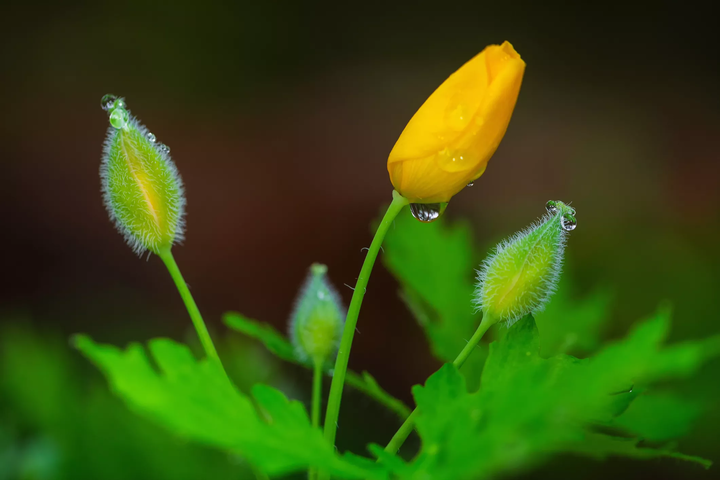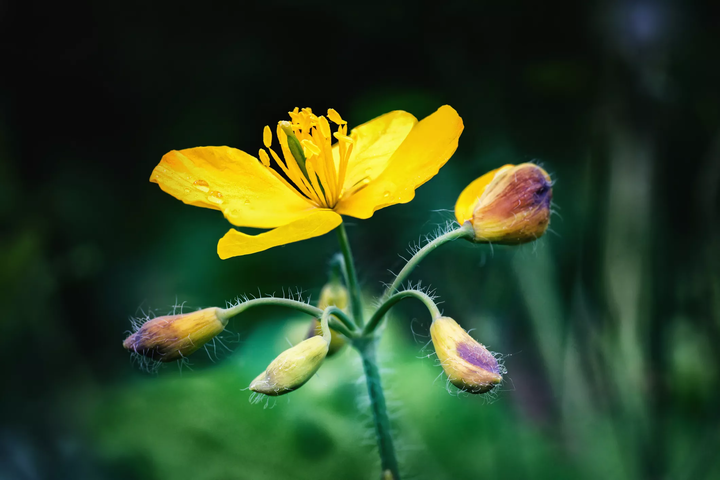Are you looking for a colorful plant to fill the shaded space under your shrubs? Or maybe some ground cover around your trees? Yellow wood poppies are a vibrant, hardy variety of poppy.
They boast bright yellow or yellow-orange flowers and fuzzy, toothed leaves. This easy-to-care-for perennial makes a fantastic addition to shade gardens and thrives in cooler regions.
Though delicate looking, it’s a hardy little plant and will winter through freezing temperatures.
Botanical Name
:Stylophorum diphyllum
Common Name
:Yellow wood poppy
Plant Type
:Perennial
Mature Size
:12 to 18 inches high
Sun Exposure
:Partial to full shade
Soil Type
:Rich, moist, and well-draining
Soil pH
:Acidic
Bloom Time
:Spring and summer
Flower Color
:Yellow to yellow-orange
Hardiness Zones
:4 to 9
Native Area
:Canada and the United States
How to Grow Yellow Wood Poppies
Yellow wood poppies make a great low-maintenance addition to the shaded areas in your garden. These plants are naturally found on forest floors, so nutrient-rich soil and dappled light are preferred.
Deadheading the old flowers will help encourage more blooms throughout the year.
This flowering plant is very easy to propagate by seed, and they readily self seed Yellow wood poppies also have no common insect or disease issues.
Light
Because the yellow wood poppy is commonly found in the forests of Canada and the northern United States, this flower likes dappled light that mimics the filtered sun in forests. Therefore, be sure to plant them in a shaded or partially shaded area.
Some great places for these poppies include under large shrubs or trees. They also make a beautiful ground cover in shaded rock gardens.
Soil
Yellow wood poppies need rich, nutrient-dense, well-draining soil—again mimicking the richness of the forest floor. Adding compost or humus will help give your poppy the nutrients and soil conditions it needs.
Water
Plenty of water is a must. Be sure to regularly water your poppy, especially if you are having a dry spell. If soil is too dry, these plants will go dormant.
Keep the soil moist, but not soggy. This can cause root rot and harm the plant. Putting a layer of mulch on top of the soil will help retain moisture in the soil.
Temperature and Humidity
Yellow wood poppies are very hardy. They handle freezing weather like a champ and make perfect additions to northern gardens.
Fertilizer
With proper soil, yellow wood poppies may not need any fertilizer. Just be sure to add lots of rich, organic material such as compost and humus.
If you want, however, you can add liquid fertilizer monthly during the growing season to help promote more growth and blooming.
Propagating Yellow Wood Poppies
Germinating Yellow Wood Poppies from seed is recommended, but you can also propagate by division. This includes uprooting your original plant and creating multiple plants from the one.
Here’s how:
1. In the spring, gently dig up your yellow poppy with a garden shovel.
2. Loosen the roots a bit with your hands. Try to keep as much soil in the roots as possible.
3. Using sharp garden shears, cut the root system into multiple parts. Be sure you keep growing points in each of the cuttings.
4. Plant each new plant in the desired location.
After division, be sure to give your poppies a good watering.
How to Grow Yellow Wood Poppies from Seeds
Propagating yellow wood poppy plants from seeds is easy. When seeds are available in fall or late summer, plant them right away.
Here’s how:
1. Gather ripe seeds as the blooming season wanes, typically in late summer or early fall.
2. Place the seeds where you would like your new poppies to grow and cover them lightly with rich soil.
3. Keep the soil moist with regular watering. Seeds planted in the fall will germinate in the spring. Therefore, let them winter in the ground, and in the spring you will have little poppy seedlings.
4. Once your poppies are 4-6” in height you may need to thin them out or move the seedlings away from each other. If you would like to move them to new locations, be sure they are 10-12” apart so as not to steal nutrients from their neighboring poppies.
That’s it. Keep them moist and watch your poppies grow. New plants will begin blooming in their second year. Another seeding option would be to start them indoors in nursery trays and put the seedlings out in the spring.
Toxicity of Yellow Wood Poppies
Yellow wood poppies are toxic if ingested, so be sure to keep any curious pets away. However, this means that animals like deer and rabbits won’t be munching on your poppies. This makes them a fantastic choice if you searching for a deer resistant flower.
Being Grown in Containers
In addition to making beautiful ground cover plants in your garden, yellow wood poppies can also be grown in containers. This method of growing helps prevent self-seeding if you would like to avoid that.
Potting requirements are similar to garden requirements. Be sure to give your container poppies soil that is rich in organic material. Place them in a shaded area and keep them well watered.
Make sure your container has drainage holes too. This will help the water drain out and keep away problems like root rot. Because of a smaller growing space, you may need to water your poppies more often to keep them moist.
Yellow Wood Poppy vs. Celandine
The yellow wood poppy is often confused for celandine, Ranunculus ficaria. Both bloom in the spring and produce small yellow flowers. A closer look at the characteristics of each plant can help you distinguish one from the other.
Celandine: These plants are more carpet-like than yellow wood poppies and choke out other plants. Though their leaves are similar, celandine leaves are rounder with shallower teeth. They produce yellow flowers with narrow petals.
If you are gardening in North America, celandine is actually an invasive species that causes harm to the native plants.

Yellow wood poppies: These plants have hairy, toothed leaves. They don’t spread out like a carpet or choke out other plants. Their flowers are much closer looking to others in the poppy family. They are slightly larger in overall size than celandine and have much wider petals that overlap.